There are numerous types of Hanfu, but some of the most notable ones include Pao, Banbi, Ruqun, Shenyi, Zhiduo, Beizi, and modern variations.
The Classification of Hanfu
Understanding the types of Hanfu is like embarking on an insightful journey through Chinese history and culture. The styles and variations are not just influenced by the period in which they were popular, but also by the regions, social statuses, and specific occasions for which they were designed. Below, we delve into the criteria used to classify Hanfu and discuss the influence of regional variations.
Criteria for Classification
When it comes to the classification of Hanfu, several key factors come into play:
- Historical Period: Hanfu styles can change dramatically depending on the dynasty in which they were worn. For instance, the opulent styles of the Tang Dynasty are notably different from the more austere fashions of the Song Dynasty.
- Social Status: The designs, materials, and even colors of Hanfu can indicate the wearer’s social standing. Royals and nobles often wore Hanfu made from luxurious fabrics like silk, adorned with intricate embroidery.
- Occasions: The purpose for which Hanfu is worn also influences its style. Ceremonial Hanfu, worn during special occasions or rituals, often feature more elaborate designs than everyday wear.
- Gender: Men’s and women’s Hanfu differ not just in terms of style but also in the cultural significance attached to them.
- Components: Hanfu can be broken down into various components like tops, bottoms, and overcoats, each with their own set of variations and styles.
For a deep dive into the historical periods affecting Hanfu, you can refer to the Hanfu Wikipedia page.
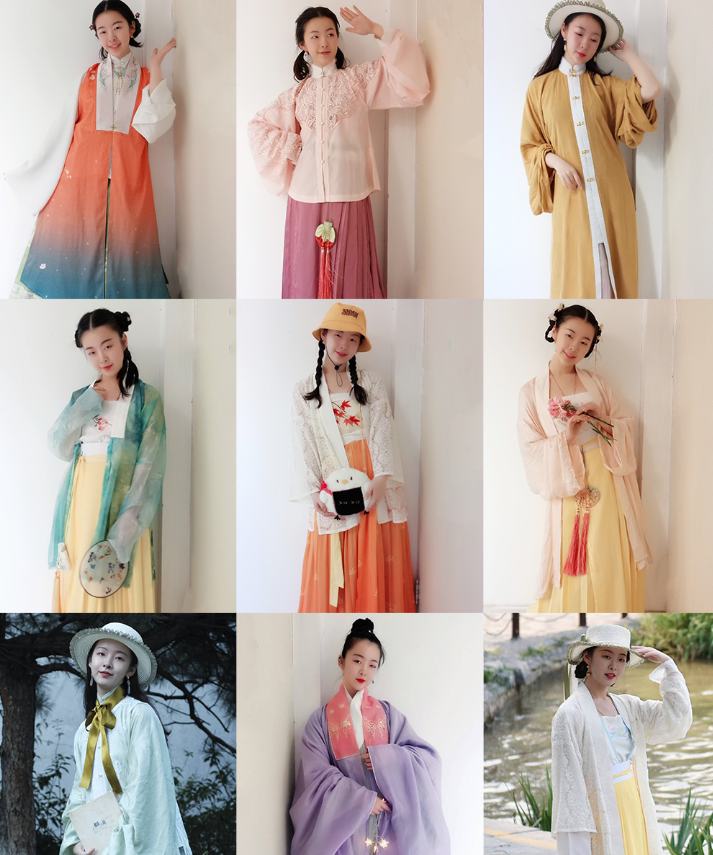
Regional Variations
China is a country rich in geographical and cultural diversity, which naturally influences Hanfu styles. Here are some of the most prominent regional variations:
- Northern Hanfu: Typically made from thicker fabrics to provide warmth, the Hanfu styles from Northern China often feature darker colors and less elaborate designs.
- Southern Hanfu: Given the warmer climate, Southern Hanfu is often lighter and made from breathable fabrics like linen. Bright colors and floral patterns are more common.
- Western Hanfu: Influenced by the cultures along the ancient Silk Road, Western Chinese Hanfu styles often incorporate foreign elements, such as Persian patterns.
- Eastern Hanfu: Known for its elaborate embroidery and luxurious fabrics, Eastern Hanfu is often considered the most “classic” style, closely resembling Hanfu from ancient Chinese paintings.
Shenyi (深衣)
Shenyi is among the most traditional forms of Hanfu and holds a special place in the annals of Chinese history and culture. This iconic attire represents a blend of formality and spiritual significance. Let’s dive into the historical background, occasions for wearing, and the variations and styles that make Shenyi unique.
Historical Background
Originating from the time of the Yellow Emperor, Shenyi dates back thousands of years and has deep roots in Chinese culture. Over the centuries, it evolved but continued to maintain its essence as an attire of great import. It was the chosen clothing for scholars and elites during ancient times and was often seen in formal and ritualistic settings. Confucian scholars particularly favored Shenyi as it resonated with their values of propriety and ritual importance. For those interested in exploring the rich history of Shenyi, the Shenyi Wikipedia page offers a wealth of information.
Occasions for Wearing
Shenyi is not your everyday outfit; it’s an attire that commands a specific occasion and setting. It is predominantly worn during formal events, religious ceremonies, and by scholars during scholarly pursuits. The garment also makes an appearance in traditional Chinese theater and cultural performances, emphasizing its ritualistic and historical significance. During traditional festivals like the Lunar New Year or the Mid-Autumn Festival, you might see people donning Shenyi as a nod to its cultural relevance.
Variations and Styles
While Shenyi maintains a traditional structure, it is far from monolithic. Over time, different styles and variations have emerged, allowing for personal expression while maintaining cultural integrity.
- Color: The color of a Shenyi can signify the wearer’s social standing or the particular occasion. Royal blue or black Shenyi often denote a sense of formality, while lighter colors might be worn for celebratory occasions.
- Material: Silk is the most commonly used fabric, but variations in cotton and linen are also available for different seasons and climates.
- Design: Shenyi usually features a top and a skirt that are connected as a single piece. However, variations in sleeve length, neckline, and the presence or absence of adornments like embroidery can differ.
- Accessories: Traditional accessories like jade belts or specific types of headwear might accompany the Shenyi, adding to its grandeur.
Ruqun (襦裙)
Ruqun is a traditional Hanfu attire that primarily consists of a top (ru) and a skirt (qun). This iconic ensemble has seen countless variations over millennia, each tailored to fit the needs of different periods, regions, and social settings. In this section, we’ll explore the historical background, occasions for wearing, and the variations and styles of Ruqun.
Historical Background
Ruqun has ancient origins and traces its lineage back to the Han Dynasty. It became the staple clothing for women in various dynasties that followed, including the Tang and Song Dynasties. The garment enjoys immense popularity even today, often seen as an embodiment of grace and femininity in Chinese culture. For those interested in delving into the history of Ruqun, the Hanfu Wikipedia page provides a detailed account.
Occasions for Wearing
Ruqun is versatile; it adapts itself to different occasions with remarkable ease. While it is a common outfit for daily wear, particularly in historical contexts, it also graces special occasions and formal events. During traditional Chinese festivals like the Spring Festival or the Lantern Festival, Ruqun gains particular prominence. It’s also a favorite for photoshoots that aim to capture the essence of traditional Chinese culture.
Variations and Styles
Ruqun is far from a one-size-fits-all garment. There are multiple variations that take into account factors such as age, social standing, and personal preference. Some of the common variations and styles include:
- Color: Ruqun comes in a variety of colors, ranging from subtle pastels for daily wear to vibrant reds and golds for special occasions. Color symbolism is strong in Chinese culture, and the choice of color in a Ruqun often carries significant meaning.
- Material: Depending on the occasion and the season, different materials like silk, cotton, or linen are used. Silk Ruqun are often more formal, while cotton and linen make for comfortable daily wear.
- Design: The design of the ru (top) can vary in terms of sleeve length, collar design, and ornamentation. The qun (skirt) can also vary in length and style, with some having additional layers or decorative elements like embroidery.
- Accessories: A complete Ruqun look often includes traditional Chinese accessories like ornate hairpins, sashes, and sometimes even handheld fans or parasols for added elegance.
Zhiduo (直裰)
Zhiduo is a Hanfu garment that is most commonly associated with Chinese men’s fashion, though it’s not exclusive to them. It usually consists of a long robe with broad sleeves and a straight collar. The simplicity and elegance of Zhiduo have made it a popular choice across various periods in Chinese history. In this section, we explore the historical background, occasions for wearing, and the variations and styles of Zhiduo.
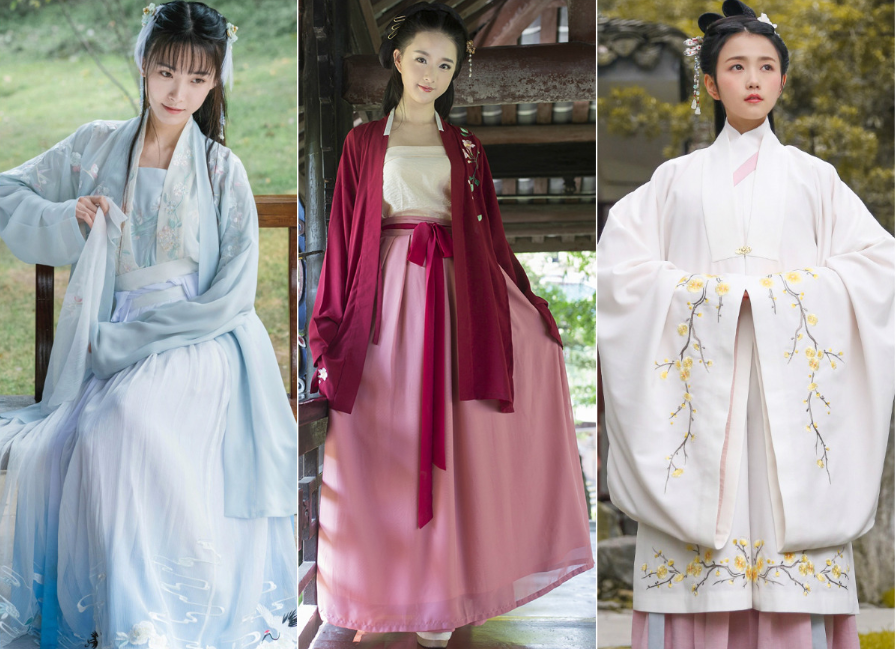
Historical Background
Zhiduo traces its roots to the Song Dynasty and was particularly popular among scholars and intellectuals. The design embodies Confucian ideals of modesty and simplicity. Over time, this garment became a staple in the Ming and Qing Dynasties as well, often symbolizing a man of learning or culture. Its appeal extends into modern times, where it serves both ceremonial and aesthetic purposes. For a more in-depth look into its historical significance, the Hanfu Wikipedia page offers plenty of information.
Occasions for Wearing
Zhiduo is a versatile garment that suits a variety of settings and occasions. While it started as a common outfit for scholars, today it is worn during various kinds of events:
- Daily Wear: In historical settings, Zhiduo was a popular choice for daily activities, especially among the educated classes.
- Formal Events: In modern times, you might see Zhiduo worn at weddings, cultural ceremonies, and other formal occasions.
- Festivals: During traditional festivals like the Lunar New Year or Confucius’ birthday, Zhiduo gains special prominence.
- Performances: In traditional Chinese theater and other cultural performances, Zhiduo often features as a costume to represent scholars or noblemen.
Variations and Styles
Though it has a relatively simple base design, Zhiduo offers several variations that make it a garment of choice for many:
- Color: Dark colors like black, navy, and deep green are often chosen for their formality and elegance. However, lighter colors are also available for less formal occasions.
- Material: Silk and brocade are popular materials for Zhiduo, lending the garment a sense of luxury and formality. For everyday wear, materials like linen and cotton are also popular.
- Sleeve Design: The sleeves can range from broad and flowing to more restrained, depending on the style and the occasion.
- Collar and Fastenings: The straight collar is a distinctive feature of Zhiduo. Variations may include different types of fastenings, from simple ties to elaborate knotted buttons.
- Accessories: Pairing Zhiduo with appropriate accessories like belts, hats, or even traditional Chinese footwear can complete the look.
For more details on the style variations of Zhiduo, the Hanfu Wikipedia page can provide further insights.
Beizi (褙子)
Beizi is a traditional Hanfu garment that has been a part of Chinese fashion for centuries. This garment is similar to a tunic and is often loose-fitting with wide sleeves. It’s been worn by both men and women, though it’s more commonly associated with women’s fashion in recent times. Below, we delve into the historical background, occasions for wearing, and the various styles and variations of Beizi.
Historical Background
Beizi made its mark during the Song Dynasty and gained widespread popularity through the Ming and Qing Dynasties. Initially worn by commoners, it eventually gained royal favor and became a versatile garment worn by people of all classes. The Beizi often featured intricate embroidery and patterns, symbolizing the wearer’s social status and artistic taste. To learn more about the history of Beizi, you can visit its Wikipedia page.
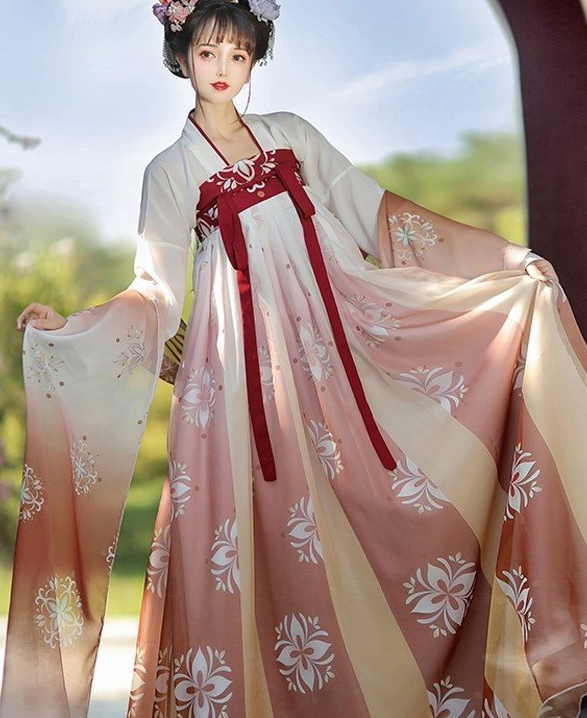
Occasions for Wearing
The versatility of Beizi makes it suitable for a wide range of settings:
- Daily Wear: Beizi serves as a comfortable option for daily activities and casual gatherings.
- Formal Occasions: In certain designs and materials, Beizi is elegant enough for formal events like weddings and cultural ceremonies.
- Festivals: During traditional festivals such as the Lunar New Year or Dragon Boat Festival, wearing a Beizi is a way to celebrate and honor Chinese heritage.
Variations and Styles
Beizi is a garment that offers a canvas for personal expression. It has several variations that account for different occasions, personal tastes, and social norms:
- Color: Beizi can be found in a variety of colors, from the subdued to the vibrant, often adorned with embroidery and patterns.
- Material: While silk is a popular choice for formal Beizi, cotton and linen versions are also available for everyday wear.
- Design Elements: The design of the sleeves, collar, and hem can vary greatly. Some have side slits for ease of movement, while others may feature detailed embroidered motifs.
- Length: Beizi can be short or long, with some versions extending to the knees, while others may go down to the ankles.
- Accessories: The garment is often paired with sashes, belts, or intricate jewelry to complete the look.
For additional information on the variations and styles of Beizi, the Hanfu Wikipedia page is a reliable source.
Banbi (半臂)
Banbi is a unique and versatile piece of Hanfu clothing. It’s a half-sleeved blouse that is usually shorter than other types of Hanfu tops. This garment is often donned by both men and women, offering a trendy yet traditional touch to any ensemble. In the following, we’ll explore Banbi’s historical background, the occasions suitable for wearing it, and its many variations and styles.
Historical Background
The Banbi has origins that can be traced back to the Tang Dynasty. While it started as a casual garment, it has evolved over the centuries into an item of elegance and style, sometimes even worn by nobility. Its simplicity and functionality have made it popular across different ages and social statuses. To dive deeper into the origins and history of Banbi, you can refer to the Hanfu Wikipedia page.
Occasions for Wearing
The Banbi’s design makes it suitable for a variety of occasions:
- Casual Wear: Its comfort and ease of movement make Banbi an excellent choice for casual daily activities.
- Summer Events: Because of its short sleeves and generally lighter material, Banbi is particularly popular during warm seasons and outdoor events.
- Festivals: During traditional events like the Mid-Autumn Festival, Banbi can be worn to celebrate the occasion in style.
- Formal Gatherings: With the right material and accessories, a Banbi can be elevated to suit formal settings like ceremonies and banquets.
Variations and Styles
Despite its simple base design, the Banbi comes in a myriad of variations:
- Color: From vibrant reds to subdued earth tones, Banbi can be found in a plethora of colors to suit different tastes and occasions.
- Material: The Banbi can be made of a variety of materials, including silk for formal events and cotton or linen for casual wear.
- Pattern and Embroidery: Some Banbi feature intricate patterns or embroidery, adding an additional layer of sophistication to the garment.
- Sleeve Style: While the basic design includes half sleeves, there are also variations that offer different sleeve lengths and styles.
- Accessories: Completing the look often involves matching the Banbi with belts, sashes, or even layered with other Hanfu garments for a fuller outfit.
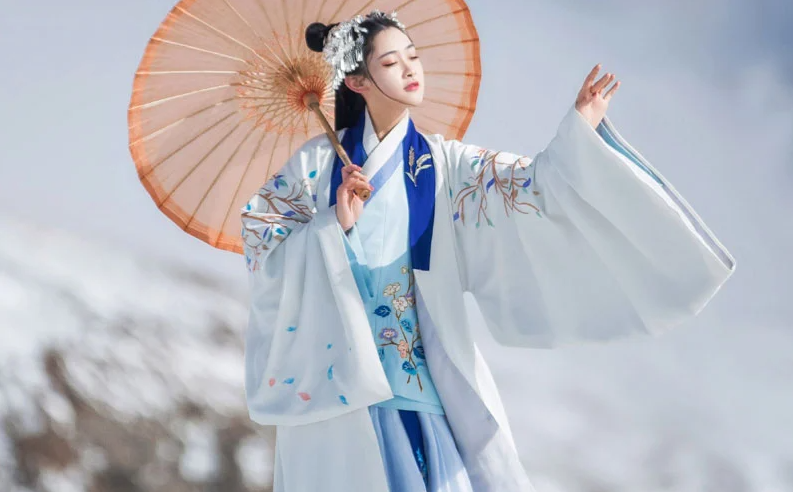
Pao (袍)
Pao is an iconic type of Hanfu garment that stands as a representation of Chinese sartorial history. Known for its long length and often full sleeves, the Pao is a one-piece robe that is versatile enough to be worn by both men and women. In this section, we’ll delve into its historical background, suitable occasions for wearing Pao, and the various styles and variations that make it unique.
Historical Background
The Pao has roots that stretch back to ancient China, with its design largely standardized during the Han Dynasty. Over the years, it became a quintessential garment worn by scholars, officials, and commoners alike. The Pao also holds ceremonial importance in various Chinese rituals and traditions. For those interested in exploring its rich history further, the Hanfu Wikipedia page provides comprehensive details.
Occasions for Wearing
Pao is an adaptable garment and has been worn on a myriad of occasions:
- Ceremonial Use: Pao has been traditionally worn in religious and imperial ceremonies, making it a garment of formal significance.
- Daily Activities: A more simple version of Pao can often be seen worn as regular clothing, particularly in historical settings.
- Festive Occasions: During major festivals like the Lunar New Year or Qixi Festival, the Pao is often donned to celebrate the cultural heritage.
- Modern Revival: Nowadays, Pao is making a comeback in modern fashion trends and is frequently worn at Hanfu gatherings and cultural events.
Variations and Styles
The Pao is a garment that can be customized in various ways to reflect individual style and societal norms:
- Color: The Pao comes in an array of colors, often signaling the wearer’s social status or the specific occasion.
- Material: Silk Pao is often the choice for more formal events, while cotton and linen versions are more breathable and suited for daily wear.
- Design: Embroideries, patterns, and even paintings could embellish the garment, adding layers of complexity and artistry.
- Sleeve Styles: Pao can have various sleeve designs, from wide and flowing to narrow and straight, based on personal preference and the requirements of the occasion.
- Length: While most Pao are long, reaching to the ankles, there are also shorter versions that stop around the knee area.
Other Types
While Hanfu garments like Pao, Banbi, and Ruqun might be well-known, there exists a spectrum of other lesser-known and modern variations that are equally rich in history and cultural significance. Let’s dive into these lesser-explored territories of Hanfu fashion.
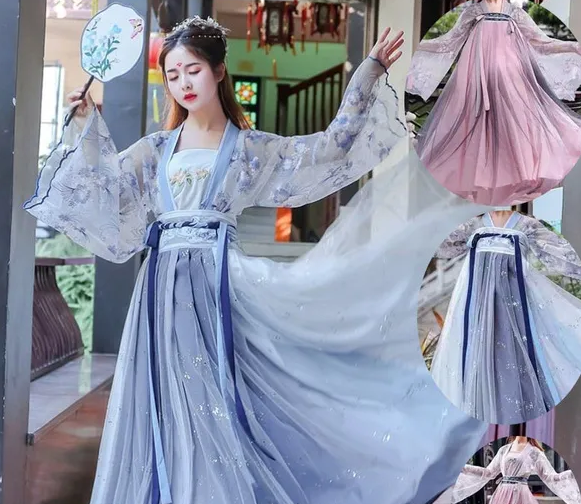
Lesser-known Types
- Yuanlingshan (圆领衫): This is a round-collared robe often worn by scholars and officials in the Ming Dynasty. It has a formal aesthetic and is usually made from high-quality materials such as silk.
- Shuhe (裋褐): Initially a garment for the commoners, Shuhe is a simple, loose-fitting tunic made of coarse fabric. It represents the minimalistic approach to clothing in ancient China.
- Tieli (贴里): Tieli is often worn under the outer garment and serves as a sort of inner lining. It adds an extra layer for warmth and comfort, especially during the colder seasons.
For those intrigued by these lesser-known types, the Hanfu Wikipedia page offers additional insights.
Modern Variations
- Short-sleeved Hanfu: This is a modern twist on traditional Hanfu, tailored to suit the summer months and casual occasions.
- Hanfu-inspired Dresses: These are modern dresses that incorporate Hanfu elements, often worn for more formal events. They blend both Western and Eastern design principles.
- Athletic Hanfu: Designed for active individuals, this variation takes traditional Hanfu concepts and adapts them for sportswear, utilizing breathable and stretchable fabrics.
- Business Hanfu: This is a fascinating blend of the traditional Hanfu style with modern business attire, offering a fresh take on corporate wear.
For a comprehensive understanding of how Hanfu has evolved into these modern forms, you can refer to the Hanfu Wikipedia page.